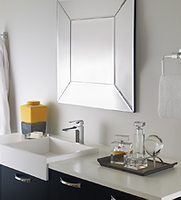Form & Function: A look at kitchen and bath trends for 2015

The annual Kitchen and Bath Industry Show (KBIS) kicks off the year for kitchen and bath designers, and sets the tone for style, form and function in that space. Taking place January 18-23 in Las Vegas, in tandem with the National Association of Homebuilders’ (NAHB) International Builders Show (IBS), KBIS will draw kitchen and bath professionals from all over the world to peruse the latest and greatest styles and products.
For most homeowners, the kitchen and bathroom are the epicenter of design in their homes. They are the rooms most likely to receive makeovers. People tend to be more selective about what goes into them than they are with other rooms in the house. Owners really want to put their own stamp on their kitchen and bathroom, and make the look like their own.
"Compliance to conventional style lessened in 2014 as homeowners worked to create a space uniquely their own," said Judd Lord, senior director of Industrial Design at Delta Faucet Company. "Homeowners mixed traditional and contemporary; old and new; as well as DIY and high-end material to create a look reflective of individual personality. The convergence of styles in 2014 encouraged homeowners to explore how new colors, finishes, texture and technology can affect their overall aesthetic."
Looking ahead to 2015, it appears that "less is more" is the fashion of the day.
"From a style point of view [in the bathroom], we have witnessed a clear shift toward cleaner, simpler and more contemporary designs for both fixtures and fittings," said Jean-Jacques L’Hénaff, vice president of Design at American Standard. "The market has been embracing a soft version of contemporary design."
"When it comes to kitchen design as a whole, many designers are ditching clutter to streamline the space and create a clean, seamless feel," Lord said. "Hidden appliances are becoming more popular. Dishwashers and refrigerators are disappearing into cabinetry, giving the feel of a more luxurious and less cluttered kitchen."
But, this does not mean a move toward spare and lifeless kitchen and bath spaces. There is an emphasis on balancing the clean looks to create an inviting aesthetic.
"Textured and tempered metals, such as clean copper, are being paired with marble to add a feeling of luxury and warmth," Lord continued. "Many homeowners are adding color and flair to their homes through a movement that is boldly feminine; pretty and practical; boisterous and bright. It is an exercise in creativity and imagination. The style brings cheerful comfort to the home through robust, oversized floral patterns, antique mirrors and frame collages."
"We see the kitchen becoming more and more the welcome heart of the home. It is a place less about status and more about conviviality," L’Hénaff said. "For example, at the more traditional end of the spectrum, we are moving away from heavier looks, like Italian and French country style, toward a more casual 'farmhouse' style with sometimes a hint of an old industrial feel."
Kitchens and bathrooms, by their very nature, are places where looks and practicality come together. This, too, is reflected in anticipated trends for 2015. Users want something that is beautiful, but also accessible, functional and efficient.
"Homeowners are creating master bathrooms, both for their own enjoyment and with the idea to increase the resale value of their homes," L’Hénaff said. "The freestanding bathtub is usually the centerpiece for this room, but its inclusion does not exclude a comprehensive showering system. Bathtubs continue to be replaced with showers. Universal access, zero-threshold showers and walk-in bathtubs are continuing to penetrate the market, though they still represent a small portion of sales. Depending on the economy, we see a continuation toward a clean, soft look in the bathroom, more shower systems and freestanding bathtubs, and more functionality in the kitchen. But, we also see an increased concern for water efficiency."
Conditions both environmental and economic have made saving water more attractive to more users.
"More than ever, consumers want to make smarter water choices in order to maintain high environmental standards and save money," Lord said. "However, they are looking to do this without compromising experience. For example, everyone wants a drenching shower and to effectively rinse the shampoo out of their hair."
"After the challenging drought season, some states experienced this past year, water conservation is becoming more of a concern in the consumer’s mind," L’Hénaff said. "The relevance of the WaterSense label should increase even further this coming year."
The demand for water efficient products seems to run contrary to the desire for luxurious, "drenching" fixtures, but product engineers and designers in the kitchen and bath industry have been hard at work developing all new approaches to creating a luxurious feel without using so much water.
"Delta offers shower heads and hand showers with H2Okinetic technology, which controls the speed, movement and droplet size of the water exiting the fixture to sculpt a unique wave pattern that creates the feeling of a warmer, more drenching experience while using less water," Lord explained. "The technology is great for building owners looking for ways to increase their water efficiency."
"Our design, engineering and innovation teams follow a user-centric approach to new-product development," L’Hénaff said. "As we monitor and strive to stay ahead of stylistic trends in our industry, American Standard also tests various new technologies to identify the ones that truly make sense for our users. Our goal is to make their lives healthier and easier, and not to clutter them with unnecessary features."
Keeping a pulse on kitchen and bath trends and consumer wants and needs is a vital component of product planning and design for manufacturers in the space. They need to be aware of where the market is going and adjust product lines appropriately.
"Overarching design trends certainly affect faucet design," Lord said. "For example, the desire for clean, simple lines is reflected in the newest faucets from Delta. The design team is constantly identifying trends and inspiration across design, travel, fashion and more, whether a new finish or the resurgence of a vintage style."
Of course, all of these trends and predictions are driven by optimism for a growing economy in 2015. As economic conditions improve, wallets open and design starts to play a larger role.
"The combination of an improving economy and the emergence of a new generation of homeowners influences these trends significantly," L’Hénaff said. "The more optimistic and younger our customers get, the more you will see this shift away from a traditional style and toward a contemporary one. Technology is also being adopted in the home at a higher rate than before, as it is getting incorporated seamlessly into products."
Moving forward into the new year, it is important for the dialogue between the industry and end users to continue since trends are such an ever-changing, dynamic thing.
Lord said, "To innovate our design, we must continue to be vigilant about finding ways to inspire, motivate and excite our customers."





